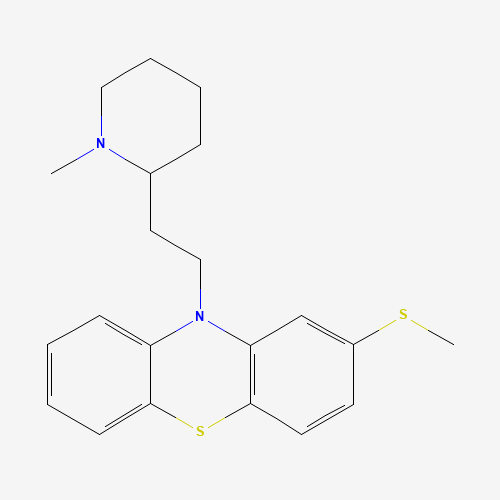| Pharmaceutical Information |
| Drug Name |
Thioridazine |
| Drug ID |
BADD_D02200 |
| Description |
A phenothiazine antipsychotic used in the management of psychoses, including schizophrenia, and in the control of severely disturbed or agitated behavior. It has little antiemetic activity. Thioridazine has a higher incidence of antimuscarinic effects, but a lower incidence of extrapyramidal symptoms, than chlorpromazine. (From Martindale, The Extra Pharmacopoeia, 30th ed, p618).
Thioridazine was withdrawn worldwide in 2005 due to its association with cardiac arrythmias. |
| Indications and Usage |
For the treatment of schizophrenia and generalized anxiety disorder. |
| Marketing Status |
approved; withdrawn |
| ATC Code |
N05AC02 |
| DrugBank ID |
DB00679
|
| KEGG ID |
D00373
|
| MeSH ID |
D013881
|
| PubChem ID |
5452
|
| TTD Drug ID |
D0U1OE
|
| NDC Product Code |
Not Available |
| UNII |
N3D6TG58NI
|
| Synonyms |
Thioridazine | Thioridazine Hydrochloride | Thioridazine HCL | Thioridazine-Neurazpharm | Thioridazine Neurazpharm | ThioridazineNeurazpharm | Thiozine | Aldazine | Meleril | Mellaril | Melleril | Melleryl | Melleretten | Melzine | Rideril | Sonapax | Apo-Thioridazine | Apo Thioridazine | ApoThioridazine |
|
| Chemical Information |
| Molecular Formula |
C21H26N2S2 |
| CAS Registry Number |
50-52-2 |
| SMILES |
CN1CCCCC1CCN2C3=CC=CC=C3SC4=C2C=C(C=C4)SC |
| Chemical Structure |

|
|
| ADRs Induced by Drug |
|
|
*The priority for ADR severity classification is based on FAERS assessment, followed by the most severe level in CTCAE rating. If neither is available, it will be displayed as 'Not available'.
**The 'Not Available' level is hidden by default and can be restored by clicking on the legend twice..
|
|
|

